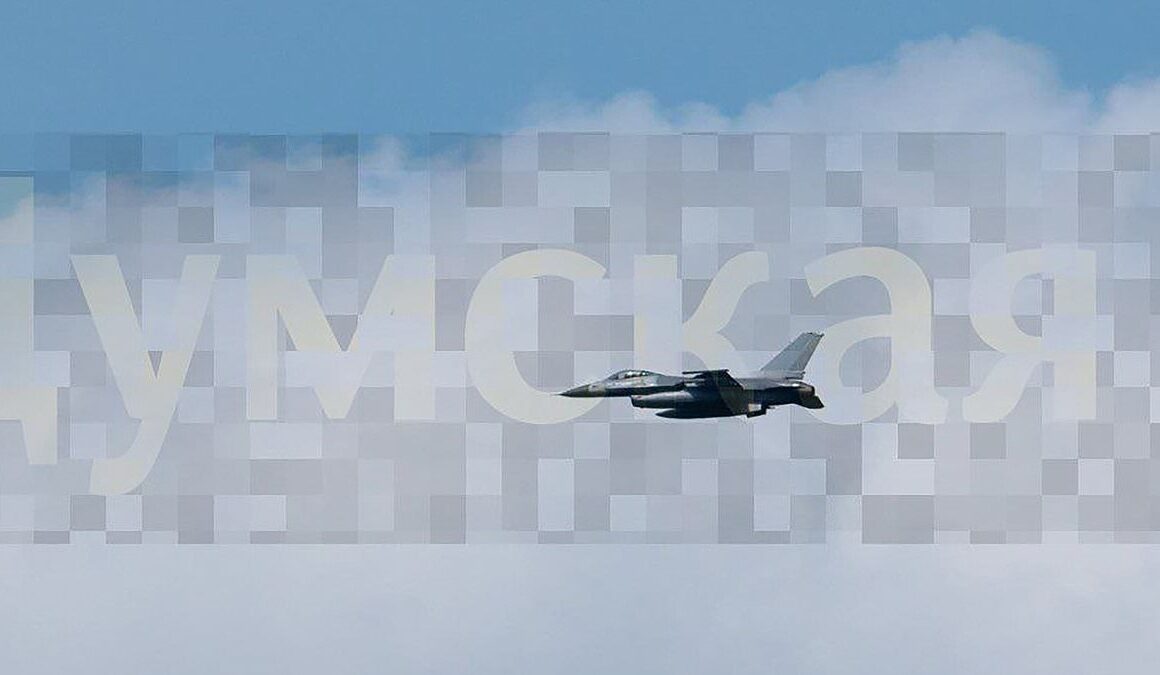The first Western fighter jets have reportedly taken flight over the skies of Ukraine after months of delays that have hamstrung Kyiv‘s war effort and left its cities susceptible to constant aerial barrages from Russian attackers.
Half a dozen US-made F-16 jets supplied by the Netherlands are believed to have arrived in the country earlier this week, with grainy images supplied by Ukrainian outlet Dumskaya claiming to show one jet soaring through the sky on its first sortie.
Ukraine will soon take delivery of additional F-16s from Denmark, Belgium and Norway in the hopes that the fourth-generation jets – long coveted by Ukrainian President Volodymyr Zelensky – will bolster Kyiv’s depleted air defences and reduce Russia’s aerial superiority.
The Ukrainian military has had to rely on a relatively small fleet of Soviet-era jets as it has fought to hold back Russia‘s full-scale February 2022 invasion.
The West has hesitantly moved toward providing the jets, after previous concerns that arming Ukraine with advanced weaponry would further escalate the war with Russia.
Ukrainian officials say the addition of the F-16 represents a vital upgrade for its Air Force, but analysts say the deployment of the jets is unlikely to prove a turning point in the war, particularly given their delayed delivery date.

Half a dozen US-made F-16 jets supplied by the Netherlands are believed to have arrived in the country earlier this week, with grainy images supplied by Ukrainian outlet Dumska claiming to show one jet soaring through the sky over Odesa

Ukraine has received the first tranche of western F-16 fighter jets that it has sought for months to be able to fight back against an onslaught of Russian missile strikes

A Royal Danish Air Force F-16 aircraft performs a demonstration flight during the fifth day of Farnborough International Airshow at Farnborough International Exhibition & Conference Centre in Farnborough, United Kingdom on July 26, 2024
F-16s, built by US aerospace firm Lockheed Martin, have been on Ukraine’s wish list for a long time because of their destructive power and global availability.
The fighter jet is equipped with a 20mm cannon and can carry bombs, rockets and missiles specialised in suppressing enemy air defences.
The F-16s could also United Kingdom-supplied Storm Shadow air-launched cruise missiles with a range of more than 250 kilometers (155 miles), potentially striking targets inside Russia.
They might also get long-range air-to-air missiles that would threaten Russian bombers and fighter jets, and the plane’s advanced radars will allow Ukrainian pilots to pinpoint targets further away than they can in their Soviet-era MiG-29s, Su-27s and Su-24s.
But the initial use of the F-16s is expected to be defensive and their pilots will likely have three core missions, said Federico Borsari of the Center for European Policy Analysis in Washington.
They will seek to intercept Russian missiles and drones that have relentlessly bombarded Ukraine, suppress enemy air defence systems, and strike Russian troop positions and ammunition depots with air-to-ground missiles.
‘They will be able to affect some of the dynamics (of the war),’ Borsari says.
Confirming the arrival of the aircraft, Lithuanian Foreign Minister Gabrielius Landsbergis said: ‘F-16s in Ukraine.
‘Another impossible thing turned out to be totally possible.’
A US official, speaking on the condition of anonymity, said the delivery had been complete, although Ukraine has not formally commented.
‘Western partners delivered the planes, as agreed, at the end of July,’ said Oleksiy Sukhoi, a military columnist for Ukrainian outlet Dumska.
‘This is undoubtedly a big step forward.’
Russia meanwhile is said to be offering a £135,000 reward for the downing or destruction of each F-16.
Vladimir Putin has stated that the warplanes would not change the situation on the battlefield, but lead to a prolongation of the war.
He claimed that they would burn like other much-touted Western military equipment, and has openly said he will authorise Russian forces to strike Ukrainian airbases hosting the NATO jets.
It is unclear whether the F-16s can be immediately deployed on combat missions or whether further training is required inside Ukraine, though the pilots and ground staff have received extensive training from NATO air forces for months.

F-16s, built by US aerospace firm Lockheed Martin, have been on Ukraine’s wish list for a long time because of their destructive power and global availability

Ukrainian President Volodymyr Zelensky, left, and Denmark’s Prime Minister Mette Frederiksen sit in a F-16 fighter jet at Skrydstrup Airbase, in Vojens, Denmark, Sunday, Aug. 20, 2023
Denmark has committed to donate 19 F-16 jets in total, while the Netherlands has promised to deliver 24 aircraft.
Both countries have been driving forces behind an international coalition to supply Ukraine with F-16s.
Norway has also said that it would donate six F-16 fighter jets to Ukraine.
The first delivery of the jets comes almost a year after US President Joe Biden gave the go-ahead in August 2023 for used F-16s to be deployed to Ukraine, though the US won’t be providing any of its own planes.
But there are still a long list of challenges that Ukraine must negotiate to effective deploy the jets, said Marina Miron of the Defense Studies Department at King’s College London.
The roughly nine-month training in the US and Europe for Ukrainian pilots amounted to a crash course compared with the usual three-year course for Western pilots in what Miron calls ‘a very complex piece of machinery.’
The F-16s also require a large number of support personnel, such as skilled maintenance engineers, munitions loaders, intelligence analysts and emergency crews.
Ukraine must also establish a network of radar stations, reinforced hangars, a supply of spare parts and refueling systems. Quality airfields are also a must as the F-16 air intake is close to the tarmac and runs the danger of sucking debris and dirt into the engine.
‘So many associated issues need to be sorted out,’ Miron says.







